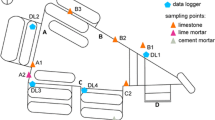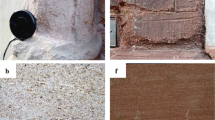Abstract
17th century stuccos located in The Valentino Castle in Turin (Northern Italy) have been studied by means of XRD, TG-DTA, Hg porosimetry and SEM coupled with EDX chemical analysis in order to understand their composition and the degradation causes. The investigated un-degraded samples were made of gypsum, hydrated lime and other carbonates phases on the external surface and up to ca. 20 mm in depth but the compositions were highly heterogeneous. Repeated cycles of water impregnation, coming from roofing infiltration, and evaporation have reached the investigated area and led to severe damages to stuccos due to crystallization of hydrated magnesium sulphate salts.
Résumé
Des stucs du XVIIe siècle sintués dans le Château du Valentino (Turin, Italie) ont été analysés par diffraction des rayons X. ATG/ATD, porosimétrie à mercure et microscopie électronique à balayage avec microanalyse EDX, pour en étudier la composition et les causes qui ont conduit à leur endommagement. L'étude des décorations intactes a montré que celles-ci ont été réalisée à base de liants aériens en surface et jusqu'à une profondeur de 20 mm, mais les compositions de différents échantillons ne sont pas du tout homogènes. Des cycles successifs d'imprégnations et d'évaporation d'eau, suite à des infiltrations répétées provenant du toit, ont sévèrement dégradé les décoration à cause de la cristallisation de sels de sulfate de magnésium.
Similar content being viewed by others
References
Roggero, C. and Scotti, A., ‘The Valentino Castle’, (L'Arciere, Turin, 1994).
Rondolet, J., ‘Theoretical—practical treatise on the art of building’, (Book 1) only available in Italian.
Curini, G., ‘The art of building, complete course of theoretical institution’, (Turin, 1864) [only available in Italian].
Montana, G. and Ronca, F., ‘The “recipe” of the stucco sculptures of Giacomo Serpotta’,J. of Cultural Heritage 3 (2002) 133–45.
Bertolini Cestari, C., Maspoli, R. and Tulliani, J.M., ‘Stucco-works from Valentino's Castle: Understanding ageing processes on the basis of the interactions between different components, the stucco/environment interface and the role of maintenance’, in ‘Lo Stucco’, Proceedings of an Italian, Conference, Bressanone, July 2001 (Arcadia Ricerche Ed., Venice 2001) 547–56 [only available in Italian].
Wirsching, F., ‘Calcium sulfate’, in ‘Uhlman's Encyclopedia of Industrial Chemistry’, VCH, Weinheim 1985) 561.
Fazeli, A.R. and Tareen, J.A.K. ‘Thermal decomposition of rhombohedral double carbonates of dolomite type’,J. Thermal Anal. 38 (1992) 2459–65.
Mackenzie, R.C., ‘Differential Thermal Analysis, Fundamental aspects’, (Academic Press Ed., London & New York, 1970).
Powell, E.K. and Searcy, A.W., ‘Kinetics and thermodynamics of decomposition of dolomite to a metastable solid product’,J. Am. Cer. Soc.,61 (5–6) (1978) 216–21.
Kristof-Mako, E. and Juhasz, A.Z., ‘In situ study of the thermal decomposition of mechanically treated dolomite’, in ‘6th European Powder Diffraction Conference (EPDIC 6)’, Proceedings of an International Conference, Budapest, August 1998 (Trans Tech Publications, Uetikon-Zürich, 1998) 380–5.
Warne, S.St.J. and Mackenzie, R.C., ‘The thermal dissociation of some carbonate minerals’,J. Thermal Anal. 3 (1971) 49–55.
Dubrawski, J.V., ‘Thermal decomposition of some sideritemagnesite minerals using DSC’,J. Thermal Anal. 37 (1991) 1213–21.
Wilburn, F.W. and Sharp, J.H., ‘The bed-depth effect in the thermal decomposition of carbonates’,J. Thermal Anal. 40 (1993) 133–40.
Sharp, J.H., Wilburn F.W. and McIntosh, R.M., ‘The effect of procedural variables on TG, DTG and DTA curves of magnesite and dolomite’,J. Thermal Anal. 37 (1991) 2021–29.
Dubravski, J.V. and Warne, S.St.J., ‘Use of differential scanning calorimetry in measuring the thermal decomposition of mineral carbonates occurring in coal’,Fuel 66 (1987) 1733–6.
Warne, S.St.J. and Dubravski, J.V., ‘Potential for coal calorific value corrections, dependent on the carbonate mineral type present’,J. Thermal Anal. 33 (1988) 435–40.
Kök, M.V. and Smykatz-Kloss, W., ‘Thermal characterization of dolomites’,J. Thermal Anal. & Cal. 64 (2001) 1271–5.
Emons, H.H., Ziegenbalg, G., Naumann, R. and Paulik, F., ‘Thermal decomposition of the magnesium sulphate hydrates under quasi-isothermal and quasi-isobaric conditions’,J. Thermal Anal.,36 (1990) 1265–79.
Odochian, L., ‘Study of the crystallization water in some magnesium hydrates by thermal methods’,J. Thermal Anal. 45 (1995) 1437–48.
Huhn, H.J., ‘High-temperature synthesis of magnesium silicates from solid mixtures of SiO2 and various magnesium compounds’,J. Thermal Anal. 33 (1988) 909–14.
Murat, M., Pusztaszeri, L. and Gremion, M., ‘Correlation between crystalline texture and mechanical properties of hardened platers. Preliminary study’,Mater. Struct. 8 (47) (1975) 377–85 [only available in French].
El H. Sadok, M. and Murat, M., ‘Study of the CaSO4−H2O systems by isothermal calorimetry,’Ciments, Bétons Plâtres et Chaux 6 (781) (1989) 398–400 [only available in French].
Ludwig, U. and Singh, N.B., ‘Hydration of hemihydrate of gypsum and its supersaturation’,Cem. & Concr. Res. 8 (1978) 291–300.
Winkler, E.M., ‘Stones in Architecture, Properties, Durability’, 3rd revised version (Springer Verlag, Berlin, 1997).
La Iglesia, A., González, V., López-Acevedo, V.L. and Viedma, C., ‘Salt crystallization in porous construction materials. I. Estimations of crystallization pressure’,J. Crystal Growth 177 (1997) 111–18.
Croce, S., Boltri, P. and Lucehini, A., ‘Design with gypsum’, (Be Ma, Milan, 1992) [only available in Italian].
Author information
Authors and Affiliations
Additional information
Editorial note Prof. Clara Bertolini Cestari is a RILEM Senior Member.
Rights and permissions
About this article
Cite this article
Tulliani, J.M., Cestari, C.B. Study of the degradation causes affecting stucco sculptures from the Valentino Castle in Turin. Mat. Struct. 38, 425–432 (2005). https://doi.org/10.1007/BF02479311
Received:
Accepted:
Issue Date:
DOI: https://doi.org/10.1007/BF02479311




